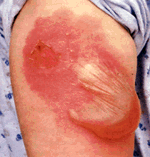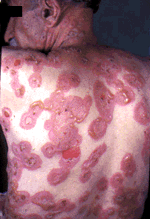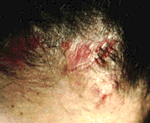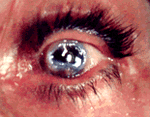PEMPHIGOID
Linear IgG is deposited on the junction between epidermis and dermis. Epidermis
detaches from dermis and subepidermal blister occurs. The roof of the blister is made
by whole epidermis. So, the blister is not easily open and tight, can reach to very large
diameters.
1. Bullous Pemphigoid
  Especially people above 70 years old are involved. Provoking
factors are drugs such as furocemide, 5-fluorouracil and penicilline, and malignancies.
Firstly erythema, papule with edema, vesicles or blisters appear on a scar belongs a
vaccine or burn, or on umbilicus as a localized phase. Wrong diagnosis may be eczema,
urticaria, erythema multiforme at this phase because of the existence of pruritus. After
several months the disease turn into generalized phase. Solitary or grouped large blisters
arranged as a circle on body and/or extremities. Prognosis is better than pemphigus and
40 mg/day prednisolone is useful and sufficient for the patients above 70 years old. Steroids
may be used higher doses for the patient younger than 70 years old. Especially people above 70 years old are involved. Provoking
factors are drugs such as furocemide, 5-fluorouracil and penicilline, and malignancies.
Firstly erythema, papule with edema, vesicles or blisters appear on a scar belongs a
vaccine or burn, or on umbilicus as a localized phase. Wrong diagnosis may be eczema,
urticaria, erythema multiforme at this phase because of the existence of pruritus. After
several months the disease turn into generalized phase. Solitary or grouped large blisters
arranged as a circle on body and/or extremities. Prognosis is better than pemphigus and
40 mg/day prednisolone is useful and sufficient for the patients above 70 years old. Steroids
may be used higher doses for the patient younger than 70 years old.
2. Cicatricial Pemphigoid
  Females are involved frequently. Mainly orifices and around of orifices are
involved. So, the disease is mainly localized to head. Attacks and remissions while
remain scars after attacks are seen. Scars become severe after every attack and lead
to function disturbances. Eye involvement may lead to blindness. Local or systemic
steroids, cytostatics or dapsone may be tried, but responses are unpredictable. Females are involved frequently. Mainly orifices and around of orifices are
involved. So, the disease is mainly localized to head. Attacks and remissions while
remain scars after attacks are seen. Scars become severe after every attack and lead
to function disturbances. Eye involvement may lead to blindness. Local or systemic
steroids, cytostatics or dapsone may be tried, but responses are unpredictable.
|

 Especially people above 70 years old are involved. Provoking
factors are drugs such as furocemide, 5-fluorouracil and penicilline, and malignancies.
Firstly erythema, papule with edema, vesicles or blisters appear on a scar belongs a
vaccine or burn, or on umbilicus as a localized phase. Wrong diagnosis may be eczema,
urticaria, erythema multiforme at this phase because of the existence of pruritus. After
several months the disease turn into generalized phase. Solitary or grouped large blisters
arranged as a circle on body and/or extremities. Prognosis is better than pemphigus and
40 mg/day prednisolone is useful and sufficient for the patients above 70 years old. Steroids
may be used higher doses for the patient younger than 70 years old.
Especially people above 70 years old are involved. Provoking
factors are drugs such as furocemide, 5-fluorouracil and penicilline, and malignancies.
Firstly erythema, papule with edema, vesicles or blisters appear on a scar belongs a
vaccine or burn, or on umbilicus as a localized phase. Wrong diagnosis may be eczema,
urticaria, erythema multiforme at this phase because of the existence of pruritus. After
several months the disease turn into generalized phase. Solitary or grouped large blisters
arranged as a circle on body and/or extremities. Prognosis is better than pemphigus and
40 mg/day prednisolone is useful and sufficient for the patients above 70 years old. Steroids
may be used higher doses for the patient younger than 70 years old.
 Females are involved frequently. Mainly orifices and around of orifices are
involved. So, the disease is mainly localized to head. Attacks and remissions while
remain scars after attacks are seen. Scars become severe after every attack and lead
to function disturbances. Eye involvement may lead to blindness. Local or systemic
steroids, cytostatics or dapsone may be tried, but responses are unpredictable.
Females are involved frequently. Mainly orifices and around of orifices are
involved. So, the disease is mainly localized to head. Attacks and remissions while
remain scars after attacks are seen. Scars become severe after every attack and lead
to function disturbances. Eye involvement may lead to blindness. Local or systemic
steroids, cytostatics or dapsone may be tried, but responses are unpredictable.